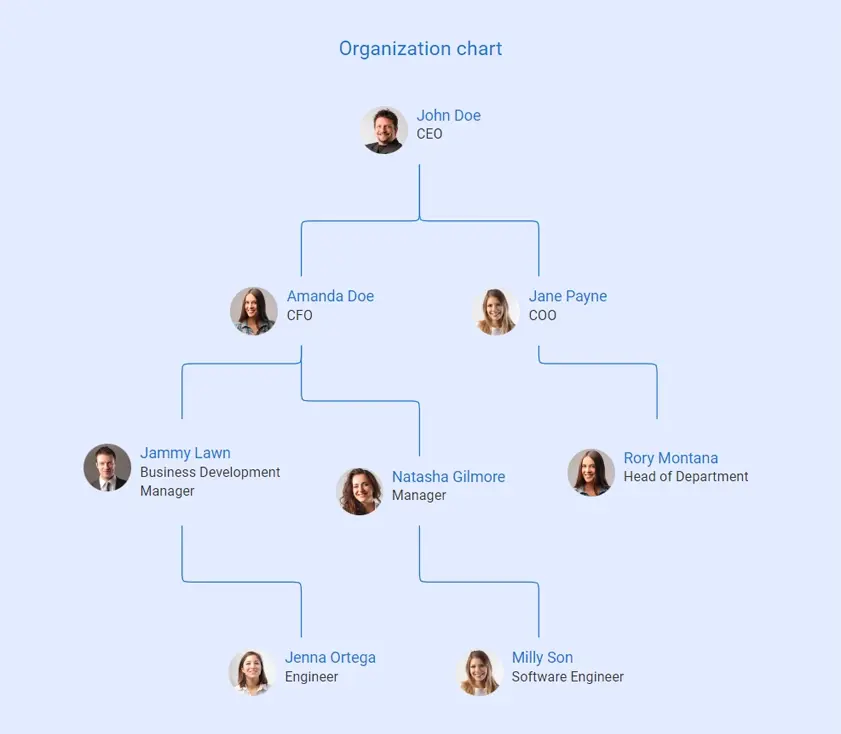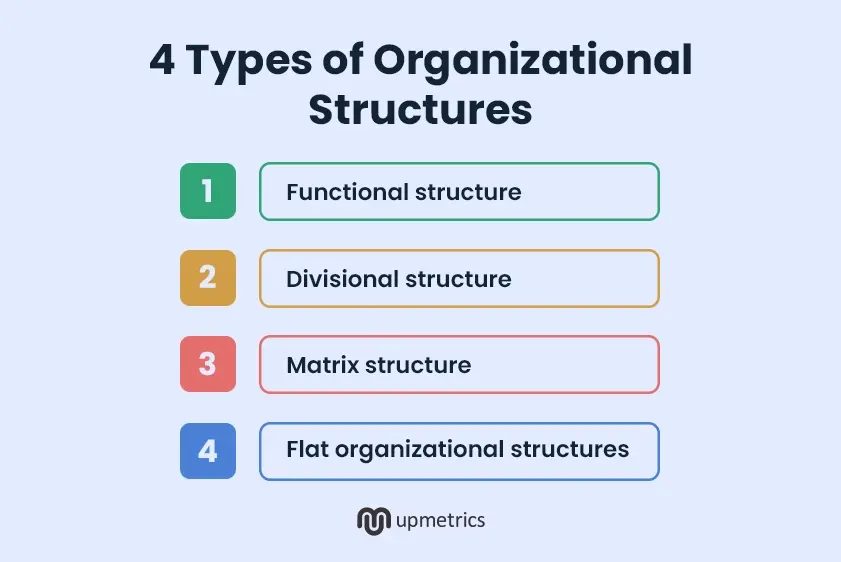Think of your organizational structure as the game plan for your business team. Without it, it’s like sending your best players onto the field with no clue who’s passing, who’s shooting, or who’s even holding the ball!
A well-thought-out structure lays out how goals are set, decisions are made, and tasks are delegated—kind of like deciding who plays defense and who’s the star forward.
Ready to draft your winning lineup?
This guide will coach you through how to create an organizational structure for your business, the importance of having one, and the different types of structure there are.
What is an organizational structure?
An organizational structure is the way your company or organization is set up such as the hierarchy and levels of management. It explains in detail your company’s workflow, policies, and team responsibilities to direct specific processes that achieve company goals.
As a result, it works as a:
- Day-to-day guide overseeing employee tasks, interactions, and reporting.
- Simple means for employees to understand where or to whom they need to go to report or ask for help.
Here’s a simple organizational structure:

The importance of having a clear organizational structure
But do you really need an organizational structure? The following points will answer your question:
1. Clear communication
When everyone is clear about each other’s positions and the line of command, communication is made simple and clear.
Everyone knows who:
- Their teammates are
- To go to, to ask for help
- To report to
- To expect work from
- To assign tasks to (for managers and leaders)
2. Clear responsibilities and hierarchy
“Hold yourselves accountable before you are held accountable.” – Umar ibn al–Khattab. A clear organizational structure helps prevent exactly that as it offers:
- A clear visual of reporting relationships
- And responsibilities in an organization.
As a result, if a deadline zooms by or a task is left incomplete, managers can quickly check the organizational structure and go “Aha!” once they find the accountable party.
Organizational structures also clearly state the hierarchy as to who reports to whom, and the scope of authority. This prevents confusion over authority as well as “too many cooks in the kitchen” scenarios.
3. Company’s growth support
Growing companies often fall prey to understaffing and overworked employee situations because of too many moving parts. But this can be avoided with an organizational structure as they can evolve with the growing company.
Managers and leads can look at the structural chart to assess areas that need more human resources or specialized experts. They can also assess if adding a middle management or reorganizing departments can help balance the workload.
4. Better planning
A clear organizational structure makes the planning of projects effective. How?
- Teams can better distribute workload thanks to a clear view availability of human resources as well as their defined roles, responsibilities, and reporting lines.
- The chain of command makes it easy to assign and oversee tasks and activities.
- By visualizing the volume of human resources available for each activity, project managers can create a calculated, accurate project schedule.
How to create an organizational structure for your business?
Ready to get organized? Here’s a simple quick guide to creating an effective organizational structure.
Step 1: Departmentalize
What kinds of departments does your company intend to have or has? Marketing? Sales? Finance? IT? List them out and organize the roles and positions within your business under each of these departments.
Step 2: Develop a chain of command
With departments set, decide who will report to whom and how under each of them. Basically, a game of hierarchy. This ensures that the instructions and decisions flow properly and outlines the expectations for staff, management, and executives.
Step 3: Choose your organizational structure type
Choosing the right organizational structure depends on your business’s size, goals, and culture.
Start by assessing your business size: Smaller companies often thrive with a simple, flat structure, fostering open communication and fast decision-making.
Whereas larger businesses work well in a hierarchical structure, where it might provide the necessary clarity in roles and responsibilities.
Then consider your goals and strategy.
Do you need flexibility and innovation? A matrix structure may work well.
Is your industry highly regulated? A functional or divisional structure can bring stability.
Lastly, think about your company culture since what works for one company might not work for yours. If you’re all about collaboration and creativity, a more fluid structure would do wonders. But if you like tight ropes and clear leadership, a more rigid structure might be best.
Balancing these factors will help you choose the most effective structure for your business.
Step 4: Determine the span of control and delegate work
Decide which leader, manager, or team member will be responsible for how many members or departments.
Then decide what expertise each department will work on so work expectations for employees are clear. This ensures that all employees are responsible and sure of their specific duties based on their level of experience and skills.
Step 5: Visualize your structure
Lastly, create a flowchart to illustrate the organizational structure you’ve planned. The visuals will ensure easy and quick understanding for all employees as to what’s expected of them to further your business’ growth and development.
Benefits of an effective organization structure for business
Here are three major benefits you’ll reap with an organizational structure in place:
1. Conflicts between individuals over authority are low
Since everyone knows their authority and place in the hierarchy, there’s a sense of responsibility instilled. As a result, no one is busy figuring out authority or reporting procedures, instead, they’re busy accomplishing assigned tasks. In fact, the work interdependency of that particular task is diminished.
2. Eliminates work duplication
When responsibilities and duties are clear as day, it reduces the risk of multiple people unknowingly working on the same thing.
3. Decreases runarounds
When teams don’t know who’s responsible for what and are sent to the wrong people for help or reporting, runarounds happen. But with a structured organization, clarity of responsibility prevents it.
4 types of organizational structures

There are four key types of organizational structures:
1. Functional structure
The most common organizational structure there is: A functional structure, which starts with positions with the highest levels of responsibility at the top and goes down from there.
It also departmentalized the organization based on employees’ job roles. For instance, there will be departments like marketing, social media, sales, finance, HR, and customer service.
2. Divisional structure
This structure consists of several smaller divisions or functional structures that perform a specific set of business operations. These divisions are based on geographic area, process, and market, where each unit works as a semi-autonomous entity.
3. Matrix structure
This one is a nontraditional organizational structure. Meaning it doesn’t follow a typical reporting hierarchy that a functional or divisional structure does.
Instead, employees report to multiple managers: typically, one for their functional area (like marketing or finance) and another for specific projects or product lines.
As a result, this structure promotes collaboration across departments, allowing for more flexible resource allocation and improved communication.
4. Flat organizational structures
Flat or organic, organizational structures can limit the level of formal management within an organization.
That’s because it has few or no levels of middle management between employees and leadership. It encourages open communication, faster decision-making, and greater employee autonomy, as team members have more direct access to top executives.
Conclusion
I hope this blog was helpful in ways you expected it to be and start creating your organizational structure today.
But there’s no pressure if you still have some reservations about the process. Just rely on Upmetrics. It can create engaging business plans that consist of clear organizational structures.
All you need to do is enter some details regarding your business including your team members and their designations to start building a suitable organizational structure and business plan!
What’s the wait? Start structuring today!


